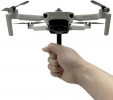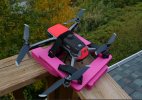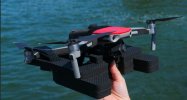Flying at sea
Flying at sea
I was recently asked to film a couple of fishing vessels while in operation in the Bearing Sea, near the renowned Dutch Harbor, AK. The first one was a 58-foot vessel and the second was 165 feet in length. Throughout the course of the 6-day expedition, I picked up a few valuable lessons. The first mission, a familiarization flight off the 58-foot vessel, was straightforward. With minimal wind, slow steady speed, no gear onboard yet, and an overhead crane up and out of the way, the flight was easy. I was able to bring the drone in ahead of me and hand-catch it. The only difficulty was the ship's movement, which necessitated constant pressure on the left stick to keep the drone ahead of me.
The initial takeaways from this experience were about turning off unnecessary functions. RTH was set to hover, all obstacle avoidance was disabled, including RTH obstacle avoidance like Avoid and braking if an obstacle is detected. Other considerations included whether the landing would be in the same orientation as the drone, whether the vessel would be stable or stopped, and whether a deck landing was an option or if hand-catching the drone was necessary. In my case, the landing was going to be a hand grab, and I had to face into the drone, which wanted to stop whenever anything came into view. This caused the drone to sit 20 plus feet behind the moving vessel.
The next challenge was maintaining a low enough altitude to avoid all obstacles, including the overhead crane, while also being high enough to clear the guardrail. It was necessary to continuously move the drone forward with the left stick or adjust the altitude with the right. This required the consideration of whether I would be wearing gloves while catching the drone mid-flight. It was also recommended to set the drone to head for home at 40% battery rather than 30%.
Coordination with the crew was another critical aspect. This may seem straightforward, but factors such as crew muscle memory and potential long hours could lead to unforeseen problems. For a two-mile filming event, I chose the Mini 3 Pro due to its extended battery life. The morning flight went well, but landing was going to be the most interesting part due to the small available area.
Things became tricky after chasing the 58-foot vessel for over two miles while shooting a video. The battery was around 35% when the Captain, focused on his next location, suddenly increased the speed. The small working area on the fantail, gear including overhead cranes stretched from port to starboard side, a port side crew shelter altering wind flow, and the need to maintain balance made landing attempts challenging.
Adding to the complexity, the drone, set to RTH to hover, decided it needed to go back to the starting point when the battery reached a critical low. Despite trying to cancel the RTH and asking the Captain to slow down, the drone had trouble landing due to the vessel's momentum and other factors like currents, tides, and wind. Eventually, the drone met the fantail, resulting in a prop strike and a short fall to the deck.
This leads to another point: nothing on a boat that a drone might interact with is soft. Always bring spare blades and remember to update your maintenance record when you change the blade and any post-impact inspections you may have to perform. Weather also plays a significant role when at sea. Fog can appear quickly, winds can change, and the boat's direction may shift.
The next vessel provided a good place to launch and recover on the forecastle deck. However, it came with its own set of challenges: pieces of equipment, railing almost 6’ above the launch point, a 195 Ton vessel chasing you down once airborne, and magnetic interference. The adrenaline rush is real, but with over 60 hours as a private pilot and more than 100 hours as a Remote PIC flying various drones, I managed to calm my nerves and safely retrieve all drones.
Obstacle avoidance and RTH are not always your friends. However, Atti mode is a great ally that will bring your drone to you wherever you are at that moment. As Randy Pausch once said, "Experience is what you get when you didn't get what you wanted. And experience is often the most valuable thing you have to offer." You can check out some of the footage I shot on my Instagram under "Tazshot".
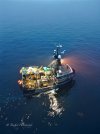
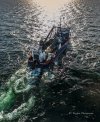
Flying at sea
I was recently asked to film a couple of fishing vessels while in operation in the Bearing Sea, near the renowned Dutch Harbor, AK. The first one was a 58-foot vessel and the second was 165 feet in length. Throughout the course of the 6-day expedition, I picked up a few valuable lessons. The first mission, a familiarization flight off the 58-foot vessel, was straightforward. With minimal wind, slow steady speed, no gear onboard yet, and an overhead crane up and out of the way, the flight was easy. I was able to bring the drone in ahead of me and hand-catch it. The only difficulty was the ship's movement, which necessitated constant pressure on the left stick to keep the drone ahead of me.
The initial takeaways from this experience were about turning off unnecessary functions. RTH was set to hover, all obstacle avoidance was disabled, including RTH obstacle avoidance like Avoid and braking if an obstacle is detected. Other considerations included whether the landing would be in the same orientation as the drone, whether the vessel would be stable or stopped, and whether a deck landing was an option or if hand-catching the drone was necessary. In my case, the landing was going to be a hand grab, and I had to face into the drone, which wanted to stop whenever anything came into view. This caused the drone to sit 20 plus feet behind the moving vessel.
The next challenge was maintaining a low enough altitude to avoid all obstacles, including the overhead crane, while also being high enough to clear the guardrail. It was necessary to continuously move the drone forward with the left stick or adjust the altitude with the right. This required the consideration of whether I would be wearing gloves while catching the drone mid-flight. It was also recommended to set the drone to head for home at 40% battery rather than 30%.
Coordination with the crew was another critical aspect. This may seem straightforward, but factors such as crew muscle memory and potential long hours could lead to unforeseen problems. For a two-mile filming event, I chose the Mini 3 Pro due to its extended battery life. The morning flight went well, but landing was going to be the most interesting part due to the small available area.
Things became tricky after chasing the 58-foot vessel for over two miles while shooting a video. The battery was around 35% when the Captain, focused on his next location, suddenly increased the speed. The small working area on the fantail, gear including overhead cranes stretched from port to starboard side, a port side crew shelter altering wind flow, and the need to maintain balance made landing attempts challenging.
Adding to the complexity, the drone, set to RTH to hover, decided it needed to go back to the starting point when the battery reached a critical low. Despite trying to cancel the RTH and asking the Captain to slow down, the drone had trouble landing due to the vessel's momentum and other factors like currents, tides, and wind. Eventually, the drone met the fantail, resulting in a prop strike and a short fall to the deck.
This leads to another point: nothing on a boat that a drone might interact with is soft. Always bring spare blades and remember to update your maintenance record when you change the blade and any post-impact inspections you may have to perform. Weather also plays a significant role when at sea. Fog can appear quickly, winds can change, and the boat's direction may shift.
The next vessel provided a good place to launch and recover on the forecastle deck. However, it came with its own set of challenges: pieces of equipment, railing almost 6’ above the launch point, a 195 Ton vessel chasing you down once airborne, and magnetic interference. The adrenaline rush is real, but with over 60 hours as a private pilot and more than 100 hours as a Remote PIC flying various drones, I managed to calm my nerves and safely retrieve all drones.
Obstacle avoidance and RTH are not always your friends. However, Atti mode is a great ally that will bring your drone to you wherever you are at that moment. As Randy Pausch once said, "Experience is what you get when you didn't get what you wanted. And experience is often the most valuable thing you have to offer." You can check out some of the footage I shot on my Instagram under "Tazshot".


Last edited:




